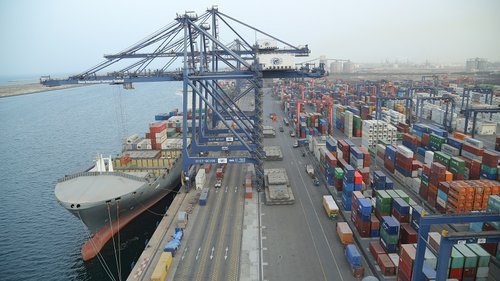The major ports in Oman are helping in attracting investments in adjoining freezones and promoting transshipment trade

Port development is an important priority area for Oman government in its long-term economic development. This is aimed at strengthening the position of Oman as a transshipment hub as well to attract foreign investment to diversify the economy. The country’s three major ports – Salalah, Sohar and Duqm – and adjoining industrial areas and free zones are all attracting investment as well as transshipment trade.
Expansion programme
The government has announced a massive expansion programme for Sohar port and freezone. The expansion project called Sohar Port South envisages an additional 200 hectares of land to the port’s present capacity of 2,000 hectares.
Besides, plans are afoot to further expand the container terminal at Sohar port. Oman government is working on a plan to build a large modern automated container terminal at the port, which will have a capacity to handle five million twenty-foot equivalent units (TEUs) per annum.
The basic infrastructure for the proposed terminal will be developed by the government, while the superstructure will be built by the container terminal operator – Oman International Container Terminal (OITC). Since the current container handling capacity of Sohar is around 2 million TEUs, the expansion will take the total container handling capacity to seven million TEUs per year, once it is ready. Apart from organic growth, the relocation of all commercial traffic from Muscat almost three years ago is a driver for recent peaks in cargo volumes, especially in containers.
Also, work on a new agro-terminal, which will support a sugar refinery and a flour mill, has already been started. Once ready, the bulk agro-terminal will be able to handle 700,000 tonnes of grain and 1.5 million tonnes of raw sugar imports per annum. Sohar Port has several advantages due to its strategic location and its access to thickly populated countries like India and Pakistan.
In yet another development, Marafi Sohar – a newly established investment arm of Asyad, has signed an agreement with Sohar Port and Freezone to develop a minerals aggregate terminal at the Omani port over two phases. A bulk terminal to accommodate a 200,000 square metre-stockpile yard will be ready by 2020. While the minerals aggregate terminal is being built, a hybrid solution will be set up at the port, so the company can capitalise on the lucrative aggregates export trade. This short-term option will see exports of aggregates, such as crushed rock, gravel and sand, leave the port by mid-September 2018.
Sohar is ideally equipped to develop high-capacity aggregate facilities, especially in view of the fact that most of the quarries producing mineral aggregate are in close proximity to the port. Apart from Sohar Port and Freezone, the government is keen to develop three other ports – Muscat, Duqm and Salalah. All these expansion programmes are aimed at repositioning the country as a major transshipment hub, besides attracting investment from within the country and outside.
Smart port
Port of Duqm also plans to transform the port into a ‘smart port’, characterised by automated terminals, truck appointment systems, integrated port community systems, use of big data, and so on. Key considerations in its upgrade into a ‘smart port’ include the roll-out of a Port Community System (PCS) that seeks to link all stakeholders — customs, agents, shippers and so on — into one online system. Also envisioned are truck appointment systems to improve productivity and efficiency, automatic gate control, terminal automation to reduce human/machine interface, crane automation, trunk radio communication, and use of big data for efficiency and optimisation.
At the same time, work has already been started for a major liquid berth, container terminal, main port office building, gates, and associated facilities. As many as four terminals will be built, including two container facilities, with a quay length of 1,600 meters, capable of handling up to 3.5 million twenty-foot equivalent units (TEUs) a year. The project also include a dry bulk terminal with a capacity of around 5 million tonnes a year and a multi-purpose terminal to handle 800,000 tonnes per annum. Duqm port, which partially started operation few years ago, has a 2.2-kilometre-long commercial quay. The commercial quay is divided into three main areas – 300 metres of cargo terminal, 1.6-km of container terminal and 300 metres for a break bulk terminal.The complete work for a fully-fledged operation of the port is expected sometime early 2020.
Transshipment hub
Salalah port, the largest container terminal and transhipment hub in Oman, also plans to expand its capacity to meet the long-term demand. An action plan for the expansion and modernisation of Salalah Port, a key maritime and logistics hub on the Indian Ocean, is being firmed by Tanfeedh — the National Programme for Enhancing Economic Diversification in the Sultanate. Tanfeedh has proposed a significant expansion of capacity at Salalah Port’s container terminal via the construction of three new berths – 7, 8 and 9. This will add 2.5 million TEUs of additional capacity to the terminal.
The expansion is necessary to exploit Salalah’s strategic location abutting international shipping lines traversing the Indian Ocean, as well as to prepare for an anticipated uptick in container shipping in the wider region. Tanfeedh has also mooted the rehabilitation of government berths, redevelopment of the old general cargo docks, and the establishment of a dedicated corridor for the movement of dry and liquid cargoes through the port.
Dedicated jetties envisioned as part of this investment will also enable the handling of liquids associated with the multibillion dollar petrochemical schemes in operation or under development at the adjoining Salalah Free Zone.
Waterfront project
In another development, the first phase of redevelopment of Muscat port has started in 2017 to make it an exclusive tourism port, which will have cruise terminals and waterfront projects. Phase one of the integrated mixed-use waterfront destination is projected to be completed by 2020, and will transform the current commercial Port Sultan Qaboos area into a major tourism-based development, spanning 64-hectare area. The Mina Al Sultan Qaboos Waterfront will include business and residential zones, destination mall, six hotels (including three-, four- and five-stars), recreation amenities and docking facilities for cruiseliners and yachts.
The development will take place over four separate phases. The master development plan was formulated in 2015, with significant inputs received from private sector investors, who are keen to capitalise on the tourism and hospitality opportunities presented by the mega waterfront scheme.
Apart from developing port facilities, the government is also keen to build a strong national shipping line. The state-owned Oman Shipping Company (OSC) has a fleet of 51 vessels, which have a combined capacity of 8 million dead-weight tonnes (DWT) now. The shipping company has succeeded in strengthening its position in the maritime transport market over the past few years.






